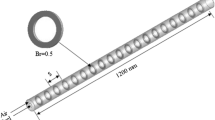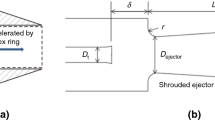Abstract
The objective of present research work is to investigate the combustion flame acceleration and performance of pulse detonation engine (PDE). The PDE tube consisting of obstacles of varying gap with fixed blockage ratio is analyzed in the current study. The three-dimensional reactive Navier–Stokes equation along with realizable k–ε turbulence model is used to simulate the combustion phenomena of hydrogen–air mixture. The one-step irreversible chemical kinetics model analyzes detailed mechanism of exothermic reaction. The propagation of flame and deflagration-to-detonation transition (DDT) run-up length is based on normal propagating regime. As the gap between combustor inner surface and obstacle outer diameter increases, the propagating area near the combustor axis reduces. Therefore, loss of momentum of turbulence combustion particle and unburnt fuel particles (voids) are increased at the wake of obstacle due to the increase in gap (or reduction in obstacle outer diameter), which results reduction in detonation wave velocity and detonation total pressure. However, DDT flame run-up length increases with lower temperature along the axis of PDE combustor. The thrust force generated by PDE combustor also gets reduced as the obstacle diameter is reduced.












Similar content being viewed by others
Abbreviations
- CJ:
-
Chapman Jouguet
- \(D_{\text{CJ}}\) :
-
Chapman Jouguet detonation speed
- \(D_{\text{i}}\) :
-
Diffusion coefficient
- \(F\) :
-
Number of moles of fuel
- h :
-
Specific enthalpy
- \(k_{\text{th}}\) :
-
Thermal conductivity
- \(M_{\text{i}}\) :
-
Symbol denoting species i
- \(n\) :
-
Number of chemical species in system
- P :
-
Pressure
- \(q_{\text{j}}\) :
-
Heat flux
- \(R_{\text{G}}\) :
-
Universal gas constant
- \(S\) :
-
Source term
- T :
-
Temperature
- \(u_{\text{ij}}\) :
-
Velocity in i and j direction
- \(W_{\text{f}}\) :
-
Molar weight of fuel
- Y i :
-
Mass fraction of ith species
- \(\alpha_{\text{i}}\) :
-
Molar fraction
- \(\nu_{\text{i,r}}^{{\prime }}\) :
-
Stoichiometric coefficient for reactant i in reaction r
- \(\nu_{\text{i,r}}^{{\prime \prime }}\) :
-
Stoichiometric coefficient for product i in reaction r
- \(\mu_{\text{t}}\) :
-
Turbulent viscosity
- \(\tau_{\text{ij}}\) :
-
Viscous stress tensor
- ρ :
-
Density
- ϕ :
-
Equivalent ratio of fuel and air
- CFD:
-
Computational fluid dynamics
- PDE:
-
Pulse detonation engine
References
Dong H, Zan W, Hong T, Zhang X. Numerical simulation of deflagration to detonation transition in granular HMX explosives under thermal ignition. J Therm Anal Calorim. 2017;127:975–81.
Liu HY, Qian XM, Du ZM. Thermal explosion model and calculation of sphere fireworks and crackers. J Therm Anal Calorim. 2012;110:1029–36.
Tangirala VE, Dean AJ, Pinard PF, Varathrajan B. Investigations of cycle processes in a pulsed detonation engine operating on fuel–air mixtures. Proc Combust Inst. 2005;30:2817–24.
Alam N, Sharma KK, Pandey KM. Numerical investigation of combustion phenomena in pulse detonation engine with different fuels. In: AIP Conference Proceedings. 2018.
Lee JH. Dynamic parameters of gaseous detonations. Ann Rev Fluid Mech. 1984;16:311–36.
Kumar PP, Kim KS, Oh S, Choi JY. Numerical comparison of hydrogen–air reaction mechanisms for unsteady shock induced combustion applications. J Mech Sci Technol. 2015;29(3):893–8.
Zhang G, Kim HD. Numerical simulation of shock wave and contact surface propagation in micro shock tubes. J Mech Sci Technol. 2015;29(4):1689–96.
Liang D, Liu J, Xiao J, Xi J, Wang Y, Zhou J. Effect of metal additives on the composition and combustion characteristics of primary combustion products of B-based propellants. J Therm Anal Calorim. 2015;122:497–508.
Heiser WH, Pratt DT. Thermodynamic cycle analysis of pulse detonation engines. J Propul Power. 2002;18(1):68–76.
Goldmeer J, Tangirala VE, Dean AJ. System-level performance estimation of a pulse detonation based hybrid engine. J Eng Gas Turb Power. 2008;130(1):011201-1–8.
Zheng K, Yu M, Zheng L, Wen X, Chu T, Wang L. Experimental study on premixed flame propagation of hydrogen/methane/air deflagration in closed ducts. Int J Hydrog Energy. 2017;42(8):5426–38.
Kellenberger M, Ciccarelli G. Propagation mechanisms of supersonic combustion waves. Proc Combust Inst. 2015;35:2109–16.
Lee JH, Moen IO. The mechanism of transition from deflagration to detonation in vapor cloud explosion. Prog Energy Combust Sci. 1980;6:359–89.
Heidari A, Wen JX. Flame acceleration and transition from deflagration to detonation in hydrogen explosions. Int J Hydrog Energy. 2014;39:6184–200.
Li J, Zhang P, Yuan L, Pan Z, Zhu Y. Flame propagation and detonation initiation distance of ethylene/oxygen in narrow gap. Appl Therm Eng. 2017;110:1274–82.
Dzieminskaand E, Hayashi AK. Auto-ignition and DDT driven by shock wave–boundary layer interaction in oxyhydrogen mixture. Int J Hydrog Energy. 2013;38:4185–93.
Gamezo VN, Ogawa T, Oran ES. Flame acceleration and DDT in channels with obstacles: effect of obstacle spacing. Combust Flame. 2008;155:302–15.
Jie L, Longxi Z, Zhiwu W, Changxin P, Xinggu C. Thrust measurement method verification and analytical studies on a liquid-fueled pulse detonation engine. Chin J Aeronaut. 2014;27(3):497–504.
Gaathaug AV, Vaagsaether K, Bjerketvedt D. Experimental and numerical investigation of DDT in hydrogen–air behind a single obstacle. Int J Hydrog Energy. 2012;37:17606–15.
Gamezo VN, Ogawa T, Oran ES. Numerical simulations of flame propagation and DDT in obstructed channels filled with hydrogen–air mixture. Proc Combust Inst. 2007;31:2463–71.
ANSYS. ANSYS fluent 14.0 theory guide. ANSYS Inc: Canonsburg; 2011. PA 15317.
Chapman S, Cowling TG. The mathematical theory of non-uniform gases. 3rd ed. Cambridge University Press: COMB; 1970.
Smirnov NN, Penyazkov OG, Sevrouk KL, Nikitin VF, Stamov LI, Tyurenkova VV. Detonation onset following shock wave focusing. Acta Astronaut. 2017;135:114–30.
Gnani F, Zare-Behtash H, White C, Kontis K. Effect of back-pressure forcing on shock train structures in rectangular channels. Acta Astronaut. 2018;145:471–81.
Alam N, Pandey KM, Sharma KK. Numerical investigation of combustion wave propagation in obstructed channel of pulse detonation engine using kerosene and butane fuels. J Appl Fluid Mech. 2019;12(3):883–90.
Alam N, Sharma KK, Pandey KM. Combustion characteristics of hydrogen–air mixture in pulse detonation engines. J Mech Sci Technol. 2019;33(5):2451–7.
Heywood JB. Internal combustion engine fundamentals. New York: McGraw-Hill; 1988.
Warnatz J, Maas U, Dibble RW. Combustion-physical and chemical fundamentals, modeling and simulations, experiments, pollutant formation. New York: Springer; 2001.
Hirschfelder JO, Gurtiss CF, Bird RB. Molecular theory of gases and liquids. J Am Chem Soc. 1955;77(7):2031–2.
Kuhl AL, Leyer JC, Borisov AA, Sirignano WA. Dynamics of gaseous combustion. Reston: AIAA; 1991.
Wei H, Shang Y, Chen C, Gao D, Feng D. One dimensional numerical study on pressure wave–flame interaction and flame acceleration under engine-relevant conditions. Int J Hydrog Energy. 2015;40:4874–83.
Anetor L, Osakue E, Odetunde C. Reduced mechanism approach of modeling premixed propane–air mixture using ANSYS fluent. Eng J. 2012;16(1):67–86.
Choubey G, Pandey KM. Effect of different strut + wall injection techniques on the performance of two-strut scramjet combustor. Int J Hydrog Energy. 2017;42:13259–75.
Choubey G, Pandey KM. Effect of parametric variation of strut layout and position on the performance of a typical two-strut based scramjet combustor. Int J Hydrog Energy. 2017;42:10485–500.
Choubey G, Pandey KM. Investigation on the effects of operating variables on the performance of two-strut scramjet combustor. Int J Hydrog Energy. 2016;42:20753–70.
Ezoji H, Shafaghat R, Jahanian O. Numerical simulation of dimethyl ether/natural gas blend fuel HCCI combustion to investigate the effects of operational parameters on combustion and emissions. J Therm Anal Calorim. 2019;135(3):1775–85.
Choubey G, Pandey KM. Effect of different wall injection schemes on the flow-field of hydrogen fuelled strut-based scramjet combustor. Acta Astronaut. 2018;145:93–104.
Phylippov YG, Dushin VR, Nikitin VF, Nerchenko VA, Korolkova NV, Guendugov VM. Fluid mechanics of pulse detonation thrusters. Acta Astronaut. 2012;76:115–26.
Betelin VB, Nikitin VF, Altukhov DI, Dushin VR, Koo J. Supercomputer modeling of hydrogen combustion in rocket engines. Acta Astronaut. 2013;89:46–59.
Smirnov NN, Betelin VB, Nikitin VF, Phylippov YG, Koo J. Detonation engine fed by acetylene–oxygen mixture. Acta Astronaut. 2014;104:134–46.
Wintenberger E, Austin JM, Cooper M, Jackson S, Shepherd JE. An analytical model for the impulse of a single-cycle pulse detonation engine. 37th AIAA/ASME/SAE/ASEE joint propulsion conference and exhibit, Salt Lake City, UT, 2001.
Kailasanath K, Patnaik G, Li C. The flow field and performance of pulse detonation engines. Proc Combust Inst. 2002;29:2855–62.
Card J, Rival D, Ciccarelli G. DDT in fuel–air mixtures at elevated temperatures and pressures. Shock Waves. 2005;14(3):167–73.
Acknowledgements
The authors would like to express gratitude to the Department of Mechanical Engineering, NIT Silchar, Assam, India for providing CFD lab facilities, and also, thankful to TEQIP III for providing financial support to carry out the research work.
Author information
Authors and Affiliations
Corresponding author
Additional information
Publisher's Note
Springer Nature remains neutral with regard to jurisdictional claims in published maps and institutional affiliations.
Rights and permissions
About this article
Cite this article
Alam, N., Sharma, K.K. & Pandey, K.M. Numerical investigation of flame propagation in pulse detonation engine with variation of obstacle clearance. J Therm Anal Calorim 140, 2485–2495 (2020). https://doi.org/10.1007/s10973-019-08948-5
Received:
Accepted:
Published:
Issue Date:
DOI: https://doi.org/10.1007/s10973-019-08948-5




